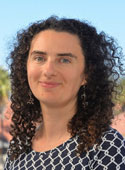Speaker
- Lacramioara Bintu, Stanford University, USA

Lacra Bintu is an Assistant Professor of Bioengineering and a member of the Biophysics Program and Bio-X Institute at Stanford University. She has B.S. in Physics, Mathematics, and Neuroscience from Brandeis University, and a PhD in Physics from University of California Berkeley. As an undergraduate working with Jané Kondev and Rob Phillips, Lacra developed a mathematical model of transcriptional regulation that uses partition functions to calculate the probability of transcription factors binding to DNA. As a graduate student working with Carlos Bustamante, she used single-molecule methods (optical tweezers and atomic force microscopy) to study the dynamics of eukaryotic transcription, and showed that RNA polymerase II cannot unwrap a nucleosome, but instead acts as a ratchet, waiting for nucleosome fluctuations to advance. As a postdoc with Michael Elowitz, Lacra used single-cell time-lapse microscopy to study chromatin-mediated gene regulation in mammalian cells, and showed that recruitment of chromatin regulators to a target gene controls the fraction of cells that are silent or maintain epigenetic memory; in this manner, cell populations can measure and remember signal durations.
Lacra started her lab at Stanford in 2017. Her lab uses high-throughput synthetic biology, single-cell measurements, and mathematical modeling to distill the basic principles of gene regulation in mammalian cells and develop new tools for gene regulation control. Her lab developed a method for testing 10,000-100,000 protein sequences in human cells for their effects on gene regulation, and used this method to discover new activation and repression domains across ~1600 human transcription factors and ~1500 viral proteins, and dissect what amino acids are important for function. The lab used nanobodies against chromatin regulators for transcriptional repression and epigenetic memory, and showed that repression and activation can spread very fast between neighboring genes even across insulators. For her work on gene regulation, Lacra won various awards, including the Harold M. Weintraub Graduate Student Award, the Jane Coffins Childs Postdoctoral Fellowship, the Career Award at the Scientific Interface (CASI) from the Burroughs Wellcome Fund, and the Maximizing Investigators' Research Award (MIRA) from the National Institute of General Medical Sciences. Lacra is co-chair of the 4D Nucleome Consortium Imaging Working Group, and a member of the Genome Technology Development Working Group of the National Human Genome Research Institute.
« Go Back